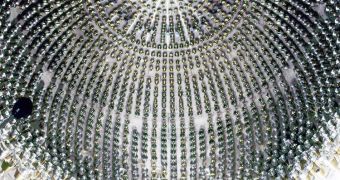A scientific experiment buried deep underground is currently conducting the most intense and rigorous investigation of solar neutrinos ever. The work is conducted in order to determine how these neutral elementary particles are influencing both our planet and ourselves.
Neutrinos have neutral electrical charges, and rarely interact with anything. They can zip through an entire planet without experiencing any distortions in their paths or energies, and they are also extremely difficult to detect.
However, scientists with the Borexino experiment at the Gran Sasso National Laboratory (GSNL) are intent on learning as much as possible about solar neutrinos. These particles have a tremendously small, near-unquantifiable mass, but their mass does exceed zero.
In the past, physicists had argued that neutrinos had no mass whatsoever, but that idea turned out to be false in the end. Through the new study, researchers can also shed light on processes going on inside the Sun itself.
It is currently estimated that neutrinos move through our planet and everything on it at a rate of 420 billion per square inch (65 billion per square centimeter). Instances when they collide with atoms are extremely rare, investigators say.
What is remarkable about the fact that neutrinos have mass is that the theories used to propose – and ultimately prove – their very existence state that these particles should be massless. The discovery that this is not so hints that we could be on the verge of discovering a new field of physics.
“We are exceeding the design sensitivity of the detector, which at its onset seemed almost impossible to reach,” University of Massachusetts in Amherst (UMA) physicist and science team member Andrea Pocar says for Space.
“The primary reason of Borexino's sensitivity is its unprecedented radiological purity – that is, ultra-low level of trace radioactivity contamination. The central 300-tonne liquid scintillator target has a content of uranium-238 and thorium-232 which is hundreds of billions times lower than in 'regular' dust,” the researcher says.
Another UMA physicist, Laura Cadonati, explains that Borexino is so sensitive that it can detect the entire spectrum of neutrinos emanating from the Sun at the same time. This ability allowed the team to confirm that neutrinos indeed oscillate between three main types, tau, muon and electron.
As they move through space, the particles can shift, or oscillate, between these three flavors, and these transformations are what give rise to their infinitely-small masses. The main implication of this finding is that existing theories explaining neutrino oscillations are correct.
Further details of the work appear in the September 30 online issue of the esteemed scientific journal Physical Review Letters.

 14 DAY TRIAL //
14 DAY TRIAL //